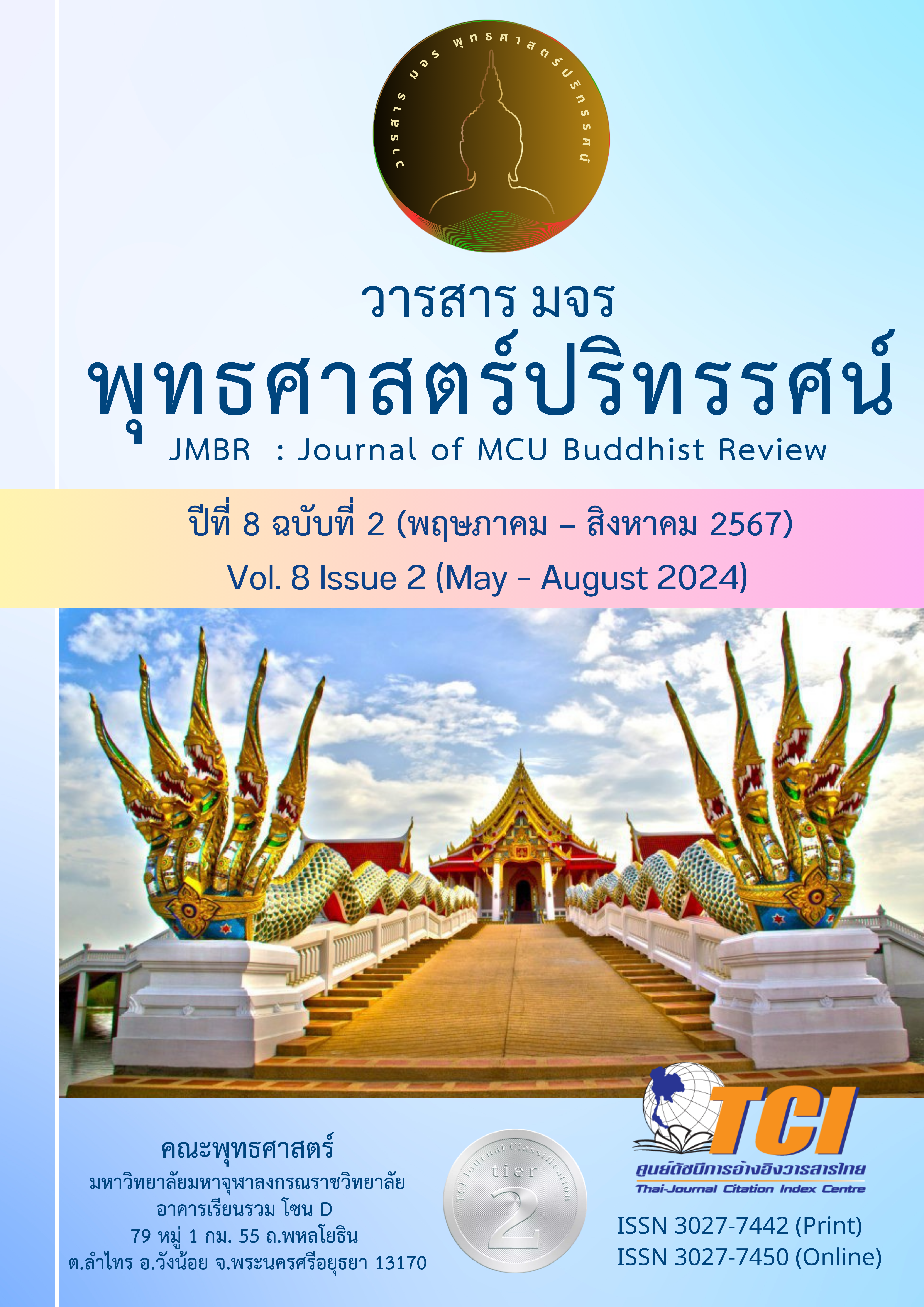การศึกษาเปรียบเทียบนิยามและพัฒนาการของชีวิตมนุษย์ตาม มิติพุทธศาสตร์กับมิติวิทยาศาสตร์การแพทย์
Main Article Content
บทคัดย่อ
บทความวิจัยนี้มีวัตถุประสงค์ 1) เพื่อศึกษาเปรียบเทียบความหมายของชีวิตมนุษย์ตามแนวคิด พุทธศาสตร์กับวิทยาศาสตร์การแพทย์ 2) เพื่อศึกษาเปรียบเทียบการกำเนิดชีวิตมนุษย์ตามแนวคิดพุทธศาสตร์กับวิทยาศาสตร์การแพทย์ 3) เพื่อศึกษาเปรียบเทียบพัฒนาการของชีวิตมนุษย์ตามแนวคิดพุทธศาสตร์กับวิทยาศาสตร์การแพทย์ เป็นการวิจัยเชิงคุณภาพ โดยศึกษาจากแหล่งข้อมูลองค์ความรู้เรื่องขันธ์ 5 ในอภิธรรมปิฎก ร่วมกับบทความเรื่องขันธ์ 5 ของสมเด็จพระพุทธโฆษาจารย์ (ป.อ.ปยุตฺโต) และ พระธรรมโกศาจารย์ (พุทธทาสภิกขุ) และในตำรากายวิภาคศาสตร์และสรีรวิทยาของวิทยาศาสตร์การแพทย์ วิเคราะห์ข้อมูลโดยใช้การวิเคราะห์เนื้อหาและนำเสนอเชิงพรรณนา
ผลการวิจัยพบว่า 1) นิยามของชีวิตตามแนวคิดพุทธศาสตร์ คือ ขันธ์ 5 ซึ่งประกอบด้วยร่างกายและจิตใจ ส่วนชีวิตตามนิยามของวิทยาศาสตร์การแพทย์ คือ ร่างกาย 2) การกำเนิดชีวิตตามแนวคิดพุทธศาสตร์จะต้องมีการเกิดของร่างกายและจิตใจ โดยร่างกายเกิดจากการปฏิสนธิระหว่างธาตุพ่อกับธาตุแม่ จิตใจเกิดจากจิตเดิมมาจุติในครรภ์มารดา ส่วนแนวคิดวิทยาศาสตร์การแพทย์มองว่าร่างกายเกิดจากการปฏิสนธิระหว่างอสุจิกับเซลล์ไข่ จิตใจเป็นผลมาจากการทำงานของสมองและระบบประสาท ดังนั้นการกำเนิดของร่างกายมีความสอดคล้องกันทั้ง 2 แนวคิด แต่ด้านจิตใจแตกต่างกัน 3) พัฒนาการของชีวิตตามแนวคิดพุทธศาสตร์อธิบายว่าร่างกายถูกสร้างมาจากธาตุ 4 วิทยาศาสตร์การแพทย์อธิบายว่าร่างกายถูกสร้างมาจากอาหาร แต่พบว่ามีความสอดคล้องกันคือธาตุ 4 สร้างร่างกายผ่านอาหาร ส่วนพัฒนาการทางด้านจิตใจตามแนวคิดพุทธศาสตร์อธิบายว่ากรรมที่สะสมสืบทอดมาจากจิตเดิมมีผลต่อพฤติกรรมที่มีมาแต่กำเนิด ร่วมกับเมื่อเติบโตขึ้นผ่านการบ่มเพาะจากครอบครัวและสังคมก็จะเกิดพฤติกรรมการเรียนรู้ ซึ่งแตกต่างจากแนวคิดวิทยาศาสตร์การแพทย์ที่มองว่าพัฒนาการทางด้านจิตใจเกิดจากการเรียนรู้ผ่านกระบวนการทำงานของสมองและระบบประสาทเท่านั้น
Article Details

อนุญาตภายใต้เงื่อนไข Creative Commons Attribution-NonCommercial-NoDerivatives 4.0 International License.
- บทความที่ได้รับการตีพิมพ์เป็นลิขสิทธิ์ของวารสาร มจร พุทธศาสตร์ปริทรรศน์
- ข้อความใดๆ ที่ปรากฎในบทความที่ได้รับการตีพิมพ์ในวารสาร ถือเป็นความรับผิดชอบของผู้เขียนบทความ และข้อคิดเห็นนั้นไม่ถือว่าเป็นทัศนะและความรับผิดชอบของกองบรรณาธิการวารสาร มจร พุทธศาสตร์ปริทรรศน์
เอกสารอ้างอิง
กฤษณา หนูเครือ. (2566). การศึกษาตำรับยาที่ปรากฏในตำราแพทย์ศาสตร์สงเคราะห์. การศึกษาอิสระหลักสูตรการแพทย์แผนไทยมหาบัณฑิต วิทยาลัยการแพทย์พื้นบ้านและการแพทย์ทางเลือก: มหาวิทยาลัยราชภัฏเชียงราย.
กองการประกอบโรคศิลปะ กรมสนับสนุนบริการสุขภาพ. (2549). ตำราแพทย์แผนโบราณทั่วไป สาขาเวชกรรมไทย เล่ม 1. นนทบุรี: บริษัท ไทภูมิ พับลิชชิ่ง จำกัด.
โกมาตร จึงเสถียรทรัพย์ และนภนาท อนุพงศ์พัฒน์. (2560). สุขภาพทางปัญญา: จิตวิญญาณ ศาสนาและความเป็นมนุษย์. นนทบุรี: สำนักงานคณะกรรมการสุขภาพแห่งชาติ.
เชาว์ ชิโนรักษ์ และพรรณี ชิโนรักษ์. (2552). ชีววิทยา เล่ม 1. กรุงเทพฯ: ศิลปาบรรณาคาร.
นิธิ เอียวศรีวงค์. (2549). ประวัติศาสตร์แห่งชาติ “ซ่อม” ฉบับเก่า “สร้าง” ฉบับใหม่. กรุงเทพฯ: เรือนแก้วการพิมพ์.
นันทพล โรจนโกศล. (2552). พุทธประสาทจริยศาสตร์กับภาวะบกพร่องทางสมอง. วิทยานิพนธ์หลักสูตรพุทธศาสตรดุษฎีบัณฑิต บัณฑิตวิทยาลัย: มหาวิทยาลัยมหาจุฬาลงกรณราชวิทยาลัย.
บัวรอง ลิ่วเฉลิมวงศ์ และคณะ. (2557). สรีรวิทยา เล่มที่ 1. ฉบับปรับปรุงครั้งที่ 5. กรุงเทพฯ: บริษัท เท็กซ์ แอนด์ เจอร์นัล พับลิเคชั่น จำกัด.
พระพรหมคุณาภรณ์ (ป.อ.ปยุตฺโต). (2549). พุทธธรรม ฉบับปรับปรุงและขยายความ. พิมพ์ครั้งที่ 11. กรุงเทพฯ: บริษัท สหธรรมิก จำกัด.
พระยาพิศณุประสาทเวช. (2450). แพทย์ศาสตร์สงเคราะห์ เล่ม 1. กรุงเทพฯ: ศุภการจำรูญถนนอัษฎางค์.
พุทธทาสภิกขุ. (2535). คู่มือมนุษย์ ฉบับสมบูรณ์. พิมพ์ครั้งที่ 5. กรุงเทพฯ: ธรรมสภา.
พุทธทาสภิกขุ. (2564). ปรมัตถสภาวธรรม. พิมพ์ครั้งที่ 4. กรุงเทพฯ: ธรรมสภา.
ภานุ อัครยรรยง และพระมหาวิโรจน์ คุตฺตวีโร. (2564). การศึกษาวิเคราะห์ขันธ์ 5 ในคัมภีร์ทางพุทธศาสนาตามทรรศนะทางวิทยาศาสตร์. วารสาร มจร บาฬีศึกษาพุทธโฆสปริทรรศน์. 7(1), 107-122.
มหาจุฬาลงกรณราชวิทยาลัย. (2539). พระไตรปิฎกภาษาไทย ฉบับมหาจุฬาลงกรณราชวิทยาลัย. กรุงเทพฯ: มหาจุฬาลงกรณราชวิทยาลัย.
ยิ่งยง เทาประเสริฐ. (2546). วิถีการดูแลรักษาสุขภาพในระบบการแพทย์พื้นบ้านล้านนา. พิมพ์ครั้งที่ 3. เชียงใหม่: วนิดา เพรส.
รำแพน พรเทพเกษมสันต์. (2556). กายวิภาคศาสตร์และสรีรวิทยาของมนุษย์. พิมพ์ครั้งที่ 6. กรุงเทพฯ: ศิลปาบรรณาคาร.
วิกัลย์ พงศ์พนิตานนท์. (2558). ชัยนาทนเรนทรานุสรณ์. กรุงเทพฯ: บริษัท อมรินทร์ พริ้นติ้งแอนด์พับลิชชิ่ง จำกัด (มหาชน).
ศิริวรรณ เกตุเพชร. (2566). การศึกษาและพัฒนาสาเหตุปัจจัยการเกิดโรคของการแพทย์แผนไทยที่ร่วมสมัย. วิทยานิพนธ์หลักสูตรการแพทย์แผนไทยดุษฎีบัณฑิต วิทยาลัยการแพทย์พื้นบ้านและการแพทย์ทางเลือก: มหาวิทยาลัยราชภัฏเชียงราย.
สุพรรษา สุขสมทรง. (2562). การประมวลโรคหรืออาการที่ปรากฏในตำราการแพทย์แผนไทย. การศึกษาอิสระหลักสูตรการแพทย์แผนไทยมหาบัณฑิต วิทยาลัยการแพทย์พื้นบ้านและการแพทย์ทางเลือก: มหาวิทยาลัยราชภัฏเชียงราย.
เสริมสุข วิจารณ์สถิต. (2561). พัฒนาการของกำเนิดมนุษย์ในครรภ์เชิงเปรียบเทียบทรรศนะเชิงพุทธศาสนาและสูติศาสตร์. วิทยานิพนธ์หลักสูตรพุทธศาสตรดุษฎีบัณฑิต บัณฑิตวิทยาลัย: มหาวิทยาลัยมหาจุฬาลงกรณราชวิทยาลัย.


